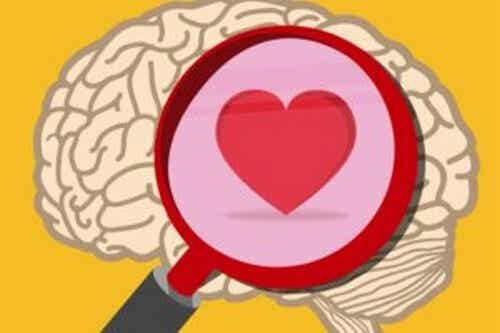Unshed tears hurt because they accumulate within us in the form of discomfort. It is then that helplessness and despondency take over. Why don't we cry?

Last update: 02 November 2020
Sometimes we are invaded by a deep anguish, the throat seems tightened by a knot and the mind enters a road with no way out. We feel sadness and helplessness. In those moments it seems to us that we cannot do anything, even with all the good will. Not even tears have the courage to look out the window. What happens, why does this outburst not happen? Why don't we cry? Have you ever felt the bitterness of unshed tears?
There are many people who, after having suffered a severe blow, are unable to release their pain. A negative experience can shock us so much that it freezes us, making us prisoners of suffering and unable to express our mood.
The bitterness of unshed tears: we would like to cry, but we can't. We would like to give words to this feeling that invades us, but we are not capable of it. The problem is that the discomfort becomes more and more cumbersome. As if, little by little, the unshed tears drowned us inside. Let's deepen.
"I almost died from all the tears I didn't shed."
- The Knight in the Rusty Armor, Robert Fisher -
The bitterness of unshed tears: why can't I cry?
The inability to cry can have various causes, from illness to emotional block. In the first place, therefore, it is important to rule out a physical problem.
For example, Siögren's syndrome is an autoimmune disease in which the glands that produce tears and saliva are destroyed, although it can also damage other parts of the body. The effect of this disease is dry eyes and mouth.
Before assuming that the inability to cry is due to psychological problems such as depression, ask your doctor.
Psychological causes
Once the physical cause is discarded, it is time to explore the psychological universe. In any case, it is good to keep in mind that not all of us handle problems in the same way. Everyone has their own special way of dealing with reality, personal reaction times and their own set of strategies.
Thus, there will be those who are able to release emotions without difficulty, those who need more time to process them and those who, for some reason, remain blocked as a backlash.
If the problem has psychological roots, it is usually linked to poor management of emotions. This is a reaction that can be limited, but sometimes a symptom of depression and other factors. If the inability to cry occurs during bereavement, and continues over time, it could indicate a pathological state of bereavement.
It is important to keep in mind what it means for each of us to cry. Sometimes the education received leads us to think that it is negative, a gesture of weakness. In fact, many tend to repress tears for fear of being considered fragile or vulnerable, until it is no longer necessary to repress them because it becomes an automatism.
In other cases, the fear of making contact with oneself is blocked. In one case or another, this attitude is not healthy, it leads to accumulation of anger and aggression, even to somatization.
"Tears shed are bitter, but the most bitter are those that are not shed."
- Irish proverb -
Releasing emotions with tears
William Frey, a psychiatrist at Saint Paul Ramsey Medical Center, assures us that tears are as necessary as smiles. Although they do not have the power to solve problems, they relieve tension and sadness, facilitate self-knowledge and connection with others.
Tears are part of us, they are a defense and outlet mechanism. In other words, a way to release the accumulated tension, regardless of the situation. For this reason it is important to allow ourselves to express them.
Lauren Bylsman, a researcher at the University of Pittsburgh, says that crying helps the body regain its state of homeostasis, or balance, which had been altered.
Crying releases adrenaline and norepinephrine, hormones that are secreted in excessive quantities in stressful situations and which can be dangerous. This produces a state of tranquility and physiological relief, so the body relaxes.
According to a study by biochemist William H. Frey, tears shed in a negative or dramatic situation they release endorphins, prolactin, potassium, magnesium chloride and other substances such as adrenocorticotropin and leucine-enkephalin. Physical and emotional discomfort is reduced thanks to the sensation produced by this emotional outburst.
Emotional release techniques
Repressing tears or not being able to cry promotes the build-up of malaise. It's like being adrift in an ocean of suffering with no life jacket or land in sight.
There are, however, some strategies that can help us release the accumulated tension and, finally, to let the first tears fall.
- Empty in the mind. It is a technique that helps to go deeper. The first step is to ask yourself what makes us sad or what prevents us from feeling good. Once we have identified the reason, we will try to answer ourselves: "I feel that ...", "it hurts me that ..."; later we will think about how to act in the future and what to do to regain that peace of mind that we so much need.
- Therapeutic writing. Writing allows us to bring out our mood. It helps to release feelings and untangle that inner skein that harnesses us. This exercise consists of describing our feelings without thinking too much. The important thing is that the writing is spontaneous.
- Review your beliefs. Reflecting on our idea of crying is just as important. Perhaps we may discover some restraints or false beliefs that keep us from crying. Thoughts like "tears are for the weak" or "men don't cry", "what's the use of crying?" I'm an example.
- Talk to a trusted person. Turning to a person capable of listening, who makes us feel understood and supported can be a valid way to feel understood and be able to free our emotions. Of course, not everyone is capable of it. We must choose who gives us confidence, security and calm.
A gesture of courage against the bitterness of unshed tears
Crying is a liberating and healthy gesture capable of transforming tension into an expression of our inner world. It helps us to release the pressure that, at times, we remain prisoners of.
In short, it facilitates emotional release and relaxes. In this way we will begin to feel more confident and we will be able to evaluate events from a new perspective.
Furthermore, tears communicate. They appeal to empathy and support from others. They pop up when words fail to describe what is overflowing from the soul, when we are unable to explain how we feel due to too much intensity.
Crying is not a sign of weakness, but of courage. The courage to convey the depth of our feelings. As the American writer Washington Irving said: “There is something sacred in tears. They are not a sign of weakness, but of power. I am the messenger of overwhelming pain and indescribable love ”.
“Tears are the blood of the soul”.
- St. Augustine -


























